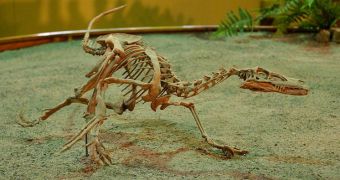Strangely, few people thought that the mighty dinosaurs may have had such a common problem as lice. Yet experts seem to believe that this was precisely the case, especially as far as the feathered of the giant lizards went.
Dinosaurs are now believed to have been affected by the same type of parasites as young children sometime are. But the discovery also has other, more significant implications as well.
It suggests that species of birds and mammals began diversifying long before the Age of Dinosaurs came to pass. The earliest giant lizards developed during the Triassic period, got bigger during the Jurassic, and achieved maximum development during the Cretaceous.
If birds and mammals were diversified before the Cretaceous-Tertiary (K-T) extinction event 65 million years ago, then this would explain their distribution later on, why they became dominant species, and also why they were not all wiped out during the massive extinction event.
According to the new study, feathered dinosaurs dealt with the same problem birds today do. Lice are a large group of insects, of which some have evolved to become efficient blood-suckers and parasite.
A variety of lice can attach itself between the barbs in a bird's feather, which means that the animal cannot remove it without removing the feather altogether. Another species of lice has evolved special grooves on its head, that enables it to grasp tightly a single strand of hair.
But this type of adaptation also carries an intrinsic risk for the lice – ultra-specialization to feeding on a single host means that they cannot easily jump species. As such, the evolution of these insects was tightly related to the evolution of their respective hosts.
“The record of our past is written in these parasites, and by reconstructing their evolutionary history we can use lice as markers to investigate the evolutionary history of their hosts,” explains Vincent Smith.
The expert, who is based at the Natural History Museum in London, says that past studies of lice helped them gain a deeper insight into the earliest clothes humans wore, and also into the history of the ancient Americas, LiveScience reports.
“Ducks do different things from owls, which do different things from parrots, for example, and it was thought that after the dinosaurs went extinct that's when these birds or mammals diversified into these different niches,” adds Kevin Johnson.
The researcher holds an appointment as an ornithologist at the University of Illinois State Natural History Survey. He explains that the “radiation of birds and mammals was already under way before the dinosaurs went extinct,” which is something researchers had no idea was possible.
"Our study shows that [lice] were around at the time of the dinosaurs,” Johnson concludes. Details of the work appear in the April 6 online issue of the esteemed scientific journal Biology Letters.

 14 DAY TRIAL //
14 DAY TRIAL //